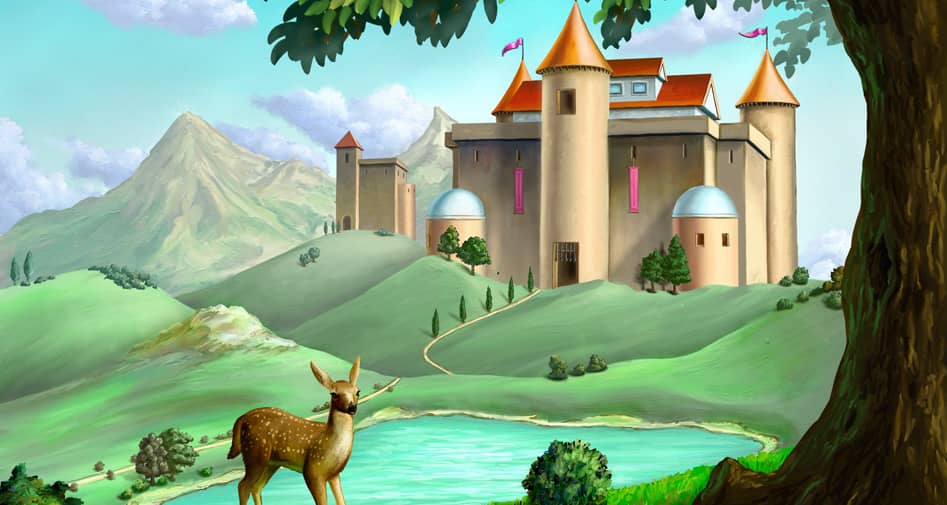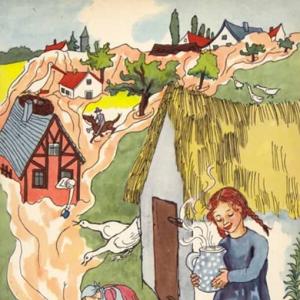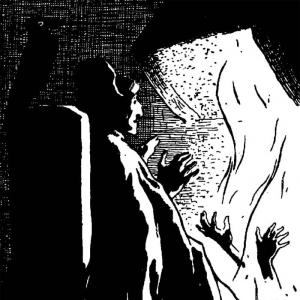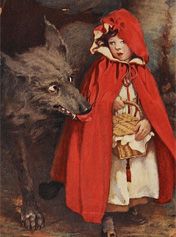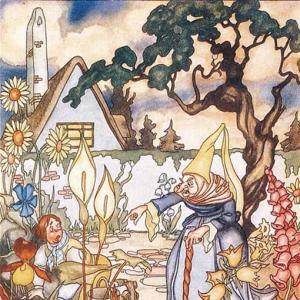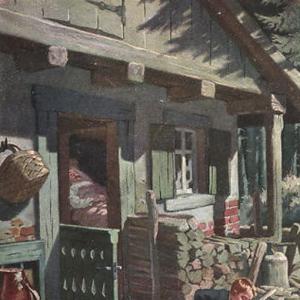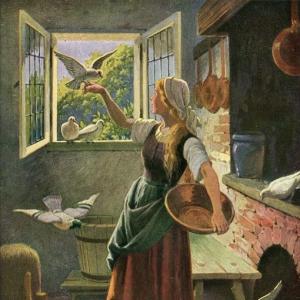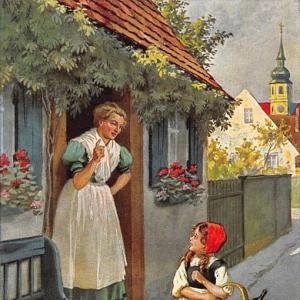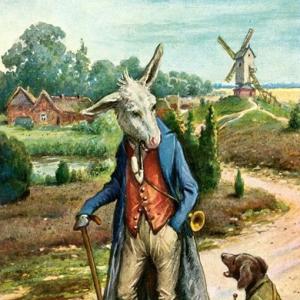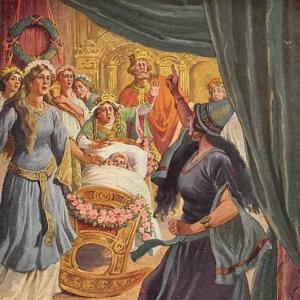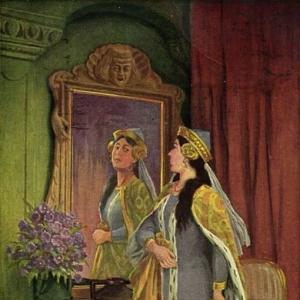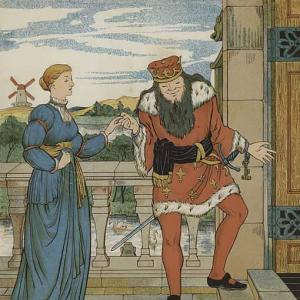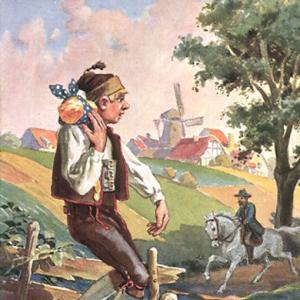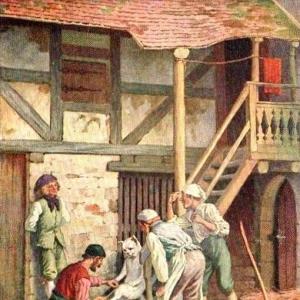Reading time for children: 15 min
In the midst of a garden grew a rose-tree, in full blossom, and in the prettiest of all the roses lived an elf. He was such a little wee thing, that no human eye could see him. Behind each leaf of the rose he had a sleeping chamber. He was as well formed and as beautiful as a little child could be, and had wings that reached from his shoulders to his feet. Oh, what sweet fragrance there was in his chambers! and how clean and beautiful were the walls! for they were the blushing leaves of the rose.
During the whole day he enjoyed himself in the warm sunshine, flew from flower to flower, and danced on the wings of the flying butterflies. Then he took it into his head to measure how many steps he would have to go through the roads and cross-roads that are on the leaf of a linden-tree. What we call the veins on a leaf, he took for roads; ay, and very long roads they were for him. For before he had half finished his task, the sun went down: he had commenced his work too late. It became very cold, the dew fell, and the wind blew. So he thought the best thing he could do would be to return home. He hurried himself as much as he could; but he found the roses all closed up, and he could not get in. Not a single rose stood open. The poor little elf was very much frightened. He had never before been out at night, but had always slumbered secretly behind the warm rose-leaves. Oh, this would certainly be his death. At the other end of the garden, he knew there was an arbor, overgrown with beautiful honey-suckles. The blossoms looked like large painted horns; and he thought to himself, he would go and sleep in one of these till the morning. He flew thither; but „hush!“ two people were in the arbor,– a handsome young man and a beautiful lady. They sat side by side, and wished that they might never be obliged to part. They loved each other much more than the best child can love its father and mother.
„But we must part,“ said the young man; „your brother does not like our engagement, and therefore he sends me so far away on business, over mountains and seas. Farewell, my sweet bride. For so you are to me.“
And then they kissed each other, and the girl wept, and gave him a rose; but before she did so, she pressed a kiss upon it so fervently that the flower opened. Then the little elf flew in, and leaned his head on the delicate, fragrant walls. Here he could plainly hear them say, „Farewell, farewell;“ and he felt that the rose had been placed on the young man’s breast. Oh, how his heart did beat! The little elf could not go to sleep, it thumped so loudly. The young man took it out as he walked through the dark wood alone, and kissed the flower so often and so violently, that the little elf was almost crushed. He could feel through the leaf how hot the lips of the young man were, and the rose had opened, as if from the heat of the noonday sun.
There came another man, who looked gloomy and wicked. He was the wicked brother of the beautiful maiden. He drew out a sharp knife, and while the other was kissing the rose, the wicked man stabbed him to death. Then he cut off his head, and buried it with the body in the soft earth under the linden-tree.
„Now he is gone, and will soon be forgotten,“ thought the wicked brother; „he will never come back again. He was going on a long journey over mountains and seas. It is easy for a man to lose his life in such a journey. My sister will suppose he is dead. For he cannot come back, and she will not dare to question me about him.“
Then he scattered the dry leaves over the light earth with his foot, and went home through the darkness; but he went not alone, as he thought,– the little elf accompanied him. He sat in a dry rolled-up linden-leaf, which had fallen from the tree on to the wicked man’s head, as he was digging the grave. The hat was on the head now, which made it very dark, and the little elf shuddered with fright and indignation at the wicked deed.
It was the dawn of morning before the wicked man reached home. He took off his hat, and went into his sister’s room. There lay the beautiful, blooming girl, dreaming of him whom she loved so, and who was now, she supposed, travelling far away over mountain and sea. Her wicked brother stopped over her, and laughed hideously, as fiends only can laugh. The dry leaf fell out of his hair upon the counterpane; but he did not notice it, and went to get a little sleep during the early morning hours. But the elf slipped out of the withered leaf, placed himself by the ear of the sleeping girl, and told her, as in a dream, of the horrid murder; described the place where her brother had slain her lover, and buried his body; and told her of the linden-tree, in full blossom, that stood close by.
„That you may not think this is only a dream that I have told you,“ he said, „you will find on your bed a withered leaf.“
Then she awoke, and found it there. Oh, what bitter tears she shed! and she could not open her heart to any one for relief.
The window stood open the whole day, and the little elf could easily have reached the roses, or any of the flowers; but he could not find it in his heart to leave one so afflicted. In the window stood a bush bearing monthly roses. He seated himself in one of the flowers, and gazed on the poor girl. Her brother often came into the room, and would be quite cheerful, in spite of his base conduct. So she dare not say a word to him of her heart’s grief.
As soon as night came on, she slipped out of the house, and went into the wood, to the spot where the linden-tree stood; and after removing the leaves from the earth, she turned it up, and there found him who had been murdered. Oh, how she wept and prayed that she also might die! Gladly would she have taken the body home with her; but that was impossible. So she took up the poor head with the closed eyes, kissed the cold lips, and shook the mould out of the beautiful hair.
„I will keep this,“ said she; and as soon as she had covered the body again with the earth and leaves, she took the head and a little sprig of jasmine that bloomed in the wood, near the spot where he was buried, and carried them home with her. As soon as she was in her room, she took the largest flower-pot she could find, and in this she placed the head of the dead man, covered it up with earth, and planted the twig of jasmine in it.
„Farewell, farewell,“ whispered the little elf. He could not any longer endure to witness all this agony of grief, he therefore flew away to his own rose in the garden. But the rose was faded; only a few dry leaves still clung to the green hedge behind it.
„Alas! how soon all that is good and beautiful passes away,“ sighed the elf.
After a while he found another rose, which became his home, for among its delicate fragrant leaves he could dwell in safety. Every morning he flew to the window of the poor girl, and always found her weeping by the flower pot. The bitter tears fell upon the jasmine twig, and each day, as she became paler and paler, the sprig appeared to grow greener and fresher. One shoot after another sprouted forth, and little white buds blossomed, which the poor girl fondly kissed. But her wicked brother scolded her, and asked her if she was going mad. He could not imagine why she was weeping over that flower-pot, and it annoyed him. He did not know whose closed eyes were there, nor what red lips were fading beneath the earth. And one day she sat and leaned her head against the flower-pot, and the little elf of the rose found her asleep. Then he seated himself by her ear, talked to her of that evening in the arbor, of the sweet perfume of the rose, and the loves of the elves. Sweetly she dreamed, and while she dreamt, her life passed away calmly and gently, and her spirit was with him whom she loved, in heaven. And the jasmine opened its large white bells, and spread forth its sweet fragrance. It had no other way of showing its grief for the dead. But the wicked brother considered the beautiful blooming plant as his own property, left to him by his sister, and he placed it in his sleeping room, close by his bed, for it was very lovely in appearance, and the fragrance sweet and delightful. The little elf of the rose followed it, and flew from flower to flower, telling each little spirit that dwelt in them the story of the murdered young man, whose head now formed part of the earth beneath them, and of the wicked brother and the poor sister. „We know it,“ said each little spirit in the flowers, „we know it, for have we not sprung from the eyes and lips of the murdered one. We know it, we know it,“ and the flowers nodded with their heads in a peculiar manner. The elf of the rose could not understand how they could rest so quietly in the matter, so he flew to the bees, who were gathering honey, and told them of the wicked brother. And the bees told it to their queen, who commanded that the next morning they should go and kill the murderer. But during the night, the first after the sister’s death, while the brother was sleeping in his bed, close to where he had placed the fragrant jasmine, every flower cup opened, and invisibly the little spirits stole out, armed with poisonous spears. They placed themselves by the ear of the sleeper, told him dreadful dreams and then flew across his lips, and pricked his tongue with their poisoned spears. „Now have we revenged the dead,“ said they, and flew back into the white bells of the jasmine flowers. When the morning came, and as soon as the window was opened, the rose elf, with the queen bee, and the whole swarm of bees, rushed in to kill him. But he was already dead. People were standing round the bed, and saying that the scent of the jasmine had killed him. Then the elf of the rose understood the revenge of the flowers, and explained it to the queen bee, and she, with the whole swarm, buzzed about the flower-pot. The bees could not be driven away. Then a man took it up to remove it, and one of the bees stung him in the hand, so that he let the flower-pot fall, and it was broken to pieces. Then every one saw the whitened skull, and they knew the dead man in the bed was a murderer. And the queen bee hummed in the air, and sang of the revenge of the flowers, and of the elf of the rose and said that behind the smallest leaf dwells One, who can discover evil deeds, and punish them also.
 Learn languages. Double-tap on a word.Learn languages in context with Childstories.org and Deepl.com.
Learn languages. Double-tap on a word.Learn languages in context with Childstories.org and Deepl.com.Backgrounds
Interpretations
Adaptions
Summary
Linguistics
„The Elf of the Rose“ is a fairy tale written by the Danish author Hans Christian Andersen, a prolific writer of stories, poems, and plays. Andersen is best known for his fairy tales, which have been translated into over 150 languages and have become an integral part of the world’s literary heritage. Some of his other famous works include „The Little Mermaid,“ „The Ugly Duckling,“ „The Emperor’s New Clothes,“ and „The Snow Queen.“
Born in 1805 in Odense, Denmark, Andersen came from humble beginnings. Despite his challenging childhood, he pursued his passion for literature and went on to become one of the most celebrated authors of his time. His fairy tales, which often incorporated elements of folklore and mythology, were initially published between 1835 and 1872.
„The Elf of the Rose“ was first published in 1839 in the collection „Fairy Tales Told for Children. New Collection. First Booklet“ (Eventyr, fortalte for Børn. Ny Samling. Første Hefte). The story draws on Andersen’s vivid imagination and skillful storytelling to create a world inhabited by magical creatures, such as the elf, and explores themes such as love, loss, and justice.
Andersen’s fairy tales have had a significant impact on popular culture, inspiring numerous adaptations across various mediums, including film, television, theater, and music. His stories have been reinterpreted and reimagined by generations of artists, and their universal themes continue to resonate with readers of all ages.
„The Elf of the Rose“ can be interpreted in various ways, touching upon themes such as love, loss, justice, and the power of nature. Here are a few interpretations of the tale.
Love and Loss: The story demonstrates the depth of the young couple’s love for one another, as well as the pain of their separation due to the wicked brother’s interference. The girl’s grief over her lover’s death and her devotion to the flower-pot containing his head show the enduring nature of love, even after death.
Justice and Retribution: The wicked brother’s ultimate demise serves as a cautionary tale about the consequences of committing evil deeds. The elf’s determination to bring the truth to light and the revenge enacted by the spirits of the flowers and bees emphasize the importance of justice and retribution in the face of wrongdoing.
The Power of Nature: The story highlights the interconnectedness of nature and humanity, as the elf, flowers, and bees all play crucial roles in the narrative. Nature is depicted as a force capable of avenging evil deeds and bringing justice, demonstrating the power and agency of even the smallest creatures.
Hidden Strength: The elf, despite his small size and seemingly insignificant existence, becomes the catalyst for exposing the wicked brother’s crimes and ensuring that justice is served. This suggests that even the most unassuming beings can have a significant impact on the world around them.
The Importance of Truth: The story underscores the value of uncovering the truth, as the elf’s determination to reveal the wicked brother’s actions brings about justice. The tale reminds readers of the importance of standing up against evil deeds and seeking the truth, no matter how difficult or daunting the task may be.
Overall, „The Elf of the Rose“ offers a rich tapestry of themes and interpretations that can resonate with readers in various ways, touching upon the human experience and the role of nature in our lives.
„The Elf of the Rose“ is a popular fairy tale by Hans Christian Andersen that has been adapted into various forms of media, including:
Ballet: The story has been adapted into a ballet production called „The Elf of the Rose Ballet,“ which has been performed by various dance companies around the world.
Animated Films: The fairy tale has been adapted into animated films, including the Russian film „The Elf of the Rose“ (1977), and the American film „Thumbelina“ (1994), which incorporates elements of „The Elf of the Rose“ into its story.
Books: „The Elf of the Rose“ has been adapted into several children’s books, including „The Elf of the Rose: A Fairy Tale“ by Silke Leffler, and „The Elf of the Rose and Other Fairy Tales“ by Hans Christian Andersen.
Theater: The story has also been adapted for the stage, with productions like „The Elf of the Rose: A Play for Children“ by Jennifer Kirkeby and Shirley Mier.
Television: „The Elf of the Rose“ has also been adapted into television shows, such as the episode „The Elf of the Rose“ from the animated TV series „The Little Mermaid“ (1992-1994).
These adaptations have helped to keep the story of „The Elf of the Rose“ alive and relevant to new generations of audiences.
„The Elf of the Rose“ is a fairy tale by Hans Christian Andersen that tells the story of a tiny elf living in a rose in a beautiful garden. The elf spends his days dancing from flower to flower and playing in the sunshine. One evening, he decides to explore a linden tree’s leaf, but night falls before he can finish his adventure. Unable to return to his rose, he seeks shelter in an arbor covered in honey-suckles. There, he witnesses a tragic scene: a young couple, deeply in love, are forced to say their farewells because the girl’s wicked brother disapproves of their relationship.
The girl gives her lover a rose, and the elf hides inside it as the young man leaves. However, the wicked brother follows and murders the young man, burying his body beneath a linden tree. The elf, horrified by the wicked deed, vows to reveal the truth to the girl. He tells her everything in a dream-like state and leaves a withered leaf as proof. Heartbroken, the girl finds her lover’s body and takes his head, burying it in a flower-pot with a jasmine sprig.
As the girl mourns, the jasmine grows and blooms, while the elf seeks revenge. He enlists the help of bees, who agree to kill the wicked brother. However, the spirits of the jasmine flowers beat them to it, poisoning the wicked brother with their spears during his sleep. The bees arrive to find him already dead, and when a man attempts to remove the jasmine flower-pot, the bees sting him, causing him to drop it and reveal the skull inside.
In the end, the wicked brother’s crimes are exposed, and the elf shares the story of the flowers‘ revenge with the queen bee. The tale emphasizes that even the smallest of creatures can bear witness to evil deeds and ensure that they are punished.
A linguistic analysis of „The Elf of the Rose“ by Hans Christian Andersen can focus on several aspects of the language used in the fairy tale, such as style, narrative techniques, symbolism, and thematic elements.
Here’s a detailed exploration:
Narrative Style and Structure:
Third-Person Omniscient Narration: The story employs a third-person omniscient narrator, which allows insights into the thoughts and emotions of various characters, including the elf, the wicked brother, and the grieving sister. This narrative style helps establish a moral tone, a common feature in Andersen’s tales.
Linear Progression with Moral Closure: The tale follows a linear progression where an initial peaceful setting turns tragic and is eventually resolved with moral justice. The story closes with an explanation of the events leading to a satisfying conclusion for the audience.
Symbolism and Imagery:
The Rose and the Elf: The rose symbolizes beauty and fragility, and the elf represents innocence and purity. These elements set up a contrast to the themes of love and betrayal explored in the narrative.
Jasmine and Transformation: The jasmine plant symbolizes transformation and revenge. It acts as a vessel of justice, embodying the spirit of the deceased young man and facilitating retribution against the wicked brother.
Nature and Justice: The integration of nature in the form of flowers and bees taking revenge suggests a larger order of justice beyond human actions. It implies that nature, with its inherent balance, can address moral wrongs.
Thematic Elements:
Love and Loss: The narrative juxtaposes profound love with loss and mourning. The tale emphasizes the endurance of love even beyond death and the transformative power of grief.
Revenge and Justice: Andersen explores the themes of revenge and justice through the interconnectedness of nature and human actions. The resolution of the story reinforces a moral order where evil is eventually punished.
Innocence and Evil: The innocent elf and the wicked brother serve as archetypes of pure good and malevolent evil, respectively. This duality is a classic fairy tale element, highlighting moral lessons about character and actions.
Language and Tone:
Descriptive Language: Vivid descriptions („sweet fragrance,“ „delicate, fragrant walls,“ „large painted horns“) contribute to the rich imagery that defines the sensory experiences of the elf and the world around him.
Dramatic Contrast: The dramatic shift from idyllic descriptions to dark and violent imagery parallels the moral descent into murder and treachery, enhancing the tale’s emotional impact.
Emotional Tone: Emotional language is used to evoke sympathy for the characters, particularly the young lovers and the grieving sister. Words such as „wept,“ „afflicted,“ and „bitter tears“ create a poignant atmosphere.
Repetition: Repetition is used to reinforce key ideas and emotions. For example, the repeated farewells between lovers emphasize their bond and impending separation.
Personification: Nature is personified, as seen in the behavior of flowers and bees, giving life to the natural elements and aligning them with human concerns.
Overall, „The Elf of the Rose“ exemplifies Andersen’s ability to weave intricate tales that blend human emotions with a moralistic universe, all expressed through rich, evocative language and vibrant symbolism.
Information for scientific analysis
Fairy tale statistics | Value |
|---|---|
| Translations | DE, EN, DA, ES, NL |
| Readability Index by Björnsson | 30.4 |
| Flesch-Reading-Ease Index | 81.2 |
| Flesch–Kincaid Grade-Level | 6.9 |
| Gunning Fog Index | 9.2 |
| Coleman–Liau Index | 7.9 |
| SMOG Index | 7.9 |
| Automated Readability Index | 7.4 |
| Character Count | 10.410 |
| Letter Count | 8.044 |
| Sentence Count | 101 |
| Word Count | 2.002 |
| Average Words per Sentence | 19,82 |
| Words with more than 6 letters | 212 |
| Percentage of long words | 10.6% |
| Number of Syllables | 2.498 |
| Average Syllables per Word | 1,25 |
| Words with three Syllables | 66 |
| Percentage Words with three Syllables | 3.3% |
